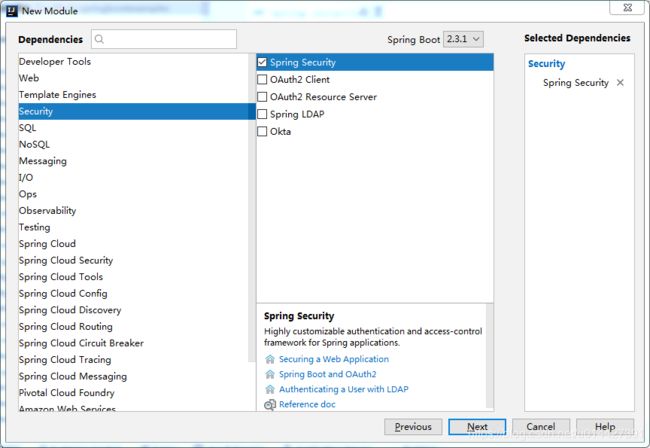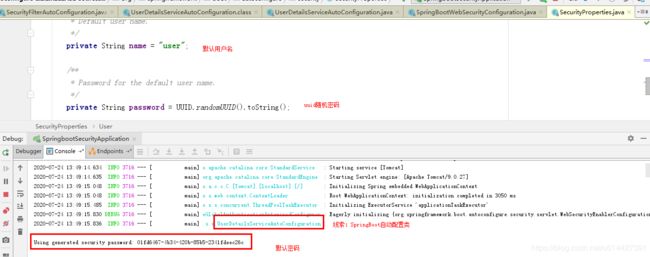@
- 1. Spring Security
- 2. 实验环境准备
- 3. 日志级别修改
- 4. 配置用户名/密码
- 5. 数据库方式校验
- 6. 不拦截静态资源
- 7. 自定义登录页面
- 8. Remember me
1. Spring Security
Spring Security 是 Spring 家族中的一个安全管理框架,应用程序的两个主要区域是“认证”和“授权”(或者访问控制)。Spring Security是针对Spring项目的安全框架,也是Spring Boot底层安全模块默认的技术选型
这两个主要区域是Spring Security 的两个目标。
- “认证”(Authentication),是建立一个他声明的主体的过程(一
个“主体”一般是指用户,设备或一些可以在你的应用程序中执行动
作的其他系统)。 - “授权”(Authorization)指确定一个主体是否允许在你的应用程序
执行一个动作的过程。为了抵达需要授权的店,主体的身份已经有认
证过程建立。
2. 实验环境准备
环境准备:
- JDK 1.8
- SpringBoot2.2.1
- Maven 3.2+
- 开发工具
- IntelliJ IDEA
- smartGit
创建一个SpringBoot Initialize项目,详情可以参考我之前博客:SpringBoot系列之快速创建项目教程

新建项目后,检查一下spring-boot-starter-security场景启动器是否配置成功,不需要写版本
org.springframework.boot
spring-boot-starter-security
SpringBoot有版本仲裁机制,SpringBoot2.2.1的spring-boot-starter-security依赖的Spring security版本是5.2.1的

3. 日志级别修改
配置Spring Security日志级别,默认是info的,可以修改为debug
## logback配置
logging:
level:
org:
springframework:
security: info
4. 配置用户名/密码
随便写个接口,访问时候,就会跳到如下图的登录页面,为什么?我们只是引入maven配置而已,然后账号密码是什么?其实这个是Spring Security的默认登录页面,页面代码是在jar包里的,默认的username是user,密码是随机生成的uuid格式的密码

密码会在控制台打印,根据线索,找到自动配置类

要修改默认密码,可以新建application.yml配置文件,加上如下配置
## spring security配置
spring:
security:
user:
name: nicky
password: 123
也可以新建Spring Security配置类,注意Spring Security5.2.1版本,配置密码要用BCryptPasswordEncoder加密,不过登录还是明文,Spring Security不同版本各有差别,详情配置还是参考官方文档
@Configuration
public class SecurityConfiguration extends WebSecurityConfigurerAdapter {
@Override
protected void configure(AuthenticationManagerBuilder auth) throws Exception { //auth.inMemoryAuthentication()
auth.inMemoryAuthentication()
.withUser("nicky")
.password(bcryptPasswordEncoder().encode("123"))
.roles("admin");
}
@Bean
public PasswordEncoder bcryptPasswordEncoder() {
return new BCryptPasswordEncoder();
}
}
| 加密方式 | security 4 | security 5 |
|---|---|---|
| bcrypt | password | {bcrypt}password |
| ldap | password | {ldap}password |
| MD4 | password | {MD4}password |
| MD5 | password | {MD5}password |
| noop | password | {noop}password |
| pbkdf2 | password | {pbkdf2}password |
| scrypt | password | {scrypt}password |
| SHA-1 | password | {SHA-1}password |
| SHA-256 | password | {SHA-256}password |
| sha256 | password | {sha256}password |
5. 数据库方式校验
拓展:如果要数据库方式校验用户名密码,可以自定义UserDetailsService方式:
@Override
protected void configure(AuthenticationManagerBuilder auth) throws Exception {
auth.userDetailsService(userDetailsService)
.passwordEncoder(new CustomPasswordEncoder());
auth.parentAuthenticationManager(authenticationManagerBean());
}
UserDetailsServiceImpl.java
package com.example.springboot.oauth2.service;
import com.example.springboot.oauth2.entity.User;
import com.example.springboot.oauth2.mapper.UserMapper;
import lombok.extern.slf4j.Slf4j;
import org.springframework.beans.factory.annotation.Autowired;
import org.springframework.security.core.authority.SimpleGrantedAuthority;
import org.springframework.security.core.userdetails.UserDetails;
import org.springframework.security.core.userdetails.UserDetailsService;
import org.springframework.security.core.userdetails.UsernameNotFoundException;
import org.springframework.stereotype.Service;
import java.util.Arrays;
import java.util.List;
/**
*
*
*
*
*
* @author mazq
* 修改记录
* 修改后版本: 修改人: 修改日期: 2020/04/30 15:15 修改内容:
*
*/
@Slf4j
@Service("userService")
public class UserDetailsServiceImpl implements UserDetailsService {
@Autowired
UserMapper userRepository;
@Override
public UserDetails loadUserByUsername(String username) throws UsernameNotFoundException {
User user = userRepository.findByUsername(username);
if(user == null){
log.info("登录用户[{}]没注册!",username);
throw new UsernameNotFoundException("登录用户["+username + "]没注册!");
}
return new org.springframework.security.core.userdetails.User(user.getUsername(), user.getPassword(), getAuthority());
}
private List getAuthority() {
return Arrays.asList(new SimpleGrantedAuthority("ROLE_ADMIN"));
// return Arrays.asList(Collections.emptyList());
}
}
@Override
protected void configure(HttpSecurity http) throws Exception {
http // 配置登录页并允许访问
.formLogin().usernameParameter("username").passwordParameter("password").loginPage("/login").permitAll()
// 配置Basic登录
//.and().httpBasic()
// 配置登出页面
.and().logout().logoutUrl("/logout").logoutSuccessUrl("/")
// 开放接口访问权限,不需要登录授权就可以访问
.and().authorizeRequests().antMatchers("/oauth/**", "/login/**", "/logout/**").permitAll()
// api接口需要admin管理员才能访问
.antMatchers("/api/**").hasRole("admin")
// 其余所有请求全部需要鉴权认证
.anyRequest().authenticated()
// 关闭跨域保护;
.and().csrf().disable();
}
6. 不拦截静态资源
配置文件,加上配置
@Override
public void configure(WebSecurity web) throws Exception {
//解决静态资源被拦截的问题
web.ignoring().antMatchers("/asserts/**");
web.ignoring().antMatchers("/favicon.ico");
}
7. 自定义登录页面
引入Thymeleaf模板引擎:
org.springframework.boot
spring-boot-starter-web
org.springframework.boot
spring-boot-starter-thymeleaf
关闭Thymeleaf模板引擎缓存,方便F9自动编译
spring:
thymeleaf:
cache: false
写个login接口,注意一定要GET方式,POST方式是Spring Security默认的校验接口,接口名称也是/login
@Controller
public class LoginController {
@GetMapping(value = {"/login"})
public ModelAndView toLogin() {
return new ModelAndView("login");
}
}
自定义登录页面,要用post方式,除非你自己写个校验接口,POST /login是Spring Security官方的校验接口,默认用户名参数为username,密码参数为password:
Signin Template for Bootstrap
修改配置文件,.loginPage("/login")指定自定义的登录页面
@Override
protected void configure(HttpSecurity http) throws Exception {
http // 配置登录页并允许访问
.formLogin().usernameParameter("username").passwordParameter("password").loginPage("/login").permitAll()
// 配置Basic登录
//.and().httpBasic()
// 配置登出页面
.and().logout().logoutUrl("/logout").logoutSuccessUrl("/")
// 开放接口访问权限,不需要登录授权就可以访问
.and().authorizeRequests().antMatchers("/oauth/**", "/login/**", "/logout/**").permitAll()
// api接口需要admin管理员才能访问
.antMatchers("/api/**").hasRole("admin")
// 其余所有请求全部需要鉴权认证
.anyRequest().authenticated()
// 关闭跨域保护;
.and().csrf().disable();
}
8. Remember me
开启记住我功能,登陆成功以后,将cookie发给浏览器保存,以后访问页面带上这个cookie,只要通过检查就可以免登录
remember me
@Override
protected void configure(HttpSecurity http) throws Exception {
//开启记住我功能,登陆成功以后,将cookie发给浏览器保存,以后访问页面带上这个cookie,只要通过检查就可以免登录
http.rememberMe().rememberMeParameter("remember-me");
}
勾选记住我,登录成功

关闭浏览器,再次登录后,是不用再次登录的

ok,Spring Security的知识点比较多,详情请参考官方文档,本博客参考官方文档,做了简单记录,仅仅作为入门参考手册
代码例子下载:code download
附录:优质Spring Security系列教程
江南一点雨大佬系列博客
Spring Security 教程(Spring Security Tutorial)
